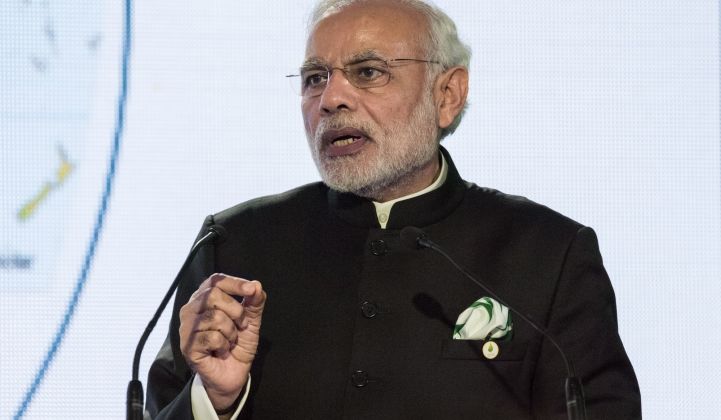Indian Prime Minister Narendra Modi slammed Trump’s protectionist policies this week, after the White House slapped 30 percent tariffs on imported solar cells and modules.
Solar developers in India hope that Modi's embrace of free trade means he'll strike down proposed Indian tariffs that could stunt the country's PV market.
Speaking at the World Economic Forum, Modi labeled protectionism as one of the world’s three biggest threats. But his government is also considering a solar import tariff more than twice as high as the one announced by the White House on Monday.
Analysts predict India’s fast-growing solar sector could be hobbled by a 70 percent safeguard duty suggested earlier this month by the director general of safeguards to protect Indian PV manufacturers from Chinese competitors.
Indian solar analysis firm Bridge to India said the rooftop solar sector could see volumes declining by up to 50 percent if anything over a 20 percent duty were to be introduced.
Large-scale PV projects, meanwhile, would increase in price by up to 35 percent, which could dissuade distribution companies (known as discoms in India) from tendering for solar.
“The discoms are obviously not keen on tariffs going up substantially from current levels, creating uncertainty for all new tenders,” said Bridge to India’s Vinay Rustagi in a blog post.
Rishab Shrestha, an analyst with GTM Research, said that even if Indian PV manufacturers favored a tariff, they lacked the capacity to serve India’s galloping solar sector.
At the end of last July, India had enough domestic manufacturing capacity to produce 3.1 gigawatts of cells and 8.8 gigawatts of modules a year, he said, although the actual amount being used was closer to 1.5 gigawatts of cells and up to 3 gigawatts of modules.
“It wouldn't be possible, with that domestic capacity, to cater to around 10+ gigawatts per year,” which is roughly the size of the PV market in India today, said Shrestha.
“I think the rate is very high for the proposal to go through,” he commented. “It's hard to imagine that the Modi government would want to jeopardize its ambitious solar plans. Discoms had already pushed back on power-purchase agreements for lower tariffs last year.”
For now, the safeguard duty proposal is on hold following a petition by Shapoorji Pallonji Infrastructure, a solar plant contractor and developer, through the Madras High Court.
Shapoorji Pallonji Infrastructure claimed the director general of safeguards had given stakeholders 30 days to respond to an inquiry initiated on behalf of the Indian Solar Manufacturers Association, but then rushed a proposal out without waiting for the deadline.
The Independent Solar Power Producers Alliance, an industry group, has also filed a petition through the Delhi High Court, asking for a stay on the director general’s recommendation, The Economic Times of India reported.
The court actions mean uncertainty over the fate of Indian solar market could drag out over “a few months,” Bridge to India said. “We expect an eventful year ahead, dogged by uncertainty, disputes and litigation.”
The analyst firm claimed to see “many developers and contractors slowing execution, as even a marginal duty imposition will make many projects unviable.”
It was against this backdrop that Modi took to the stage this week at Davos and issued an impassioned plea for free trade that many saw as a thinly veiled attack on American protectionist measures, most recently exemplified by a tariff on imported solar cells and modules.
“Modi, making the forum’s first speech by an Indian head of state in more than two decades, did not mention Trump by name but he criticized the rise of protectionism in remarks delivered three days before the U.S. president will address the summit,” Reuters said.
In an analysis released this week, GTM Research concluded that the 30 percent import tariff issued by the Trump administration could cut U.S. solar installations by 11 percent over the next five years.
“This represents a reduction of 7.6 gigawatts of installed solar PV capacity between 2018 and 2022,” according to GTM Research.
India’s solar developers are hoping Modi’s free-market stance at Davos can help the Indian market avoid a similar fate.
--
Join us for the 11th annual Solar Summit 2018 in San Diego, May 1-2. Powered by the unique blend of research and economic analysis from the GTM Research team, this year's agenda will feature themes from beyond traditional project finance to innovations in solar and the transformation of electricity.




